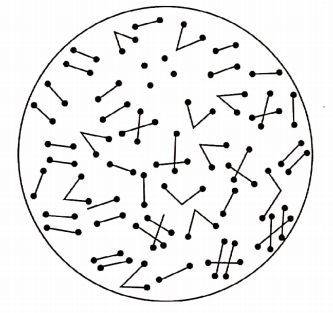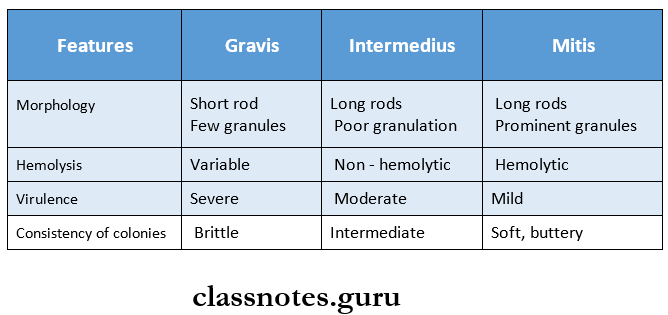Corynebacterium
Question 1. Describe the morphology, cultural characteristic, and laboratory diagnosis of Corynebacterium diphtheria.
Answer:
Corynebacterium Diphtheria:
- Morphology:
- C. Diphtheria bacillus are thin slender rods.
- Corynebacterium Diphtheria are gram-positive bacilli.
- Corynebacterium Diphtheria are pleomorphic, nonsporting, non-motile, and non-capsulated.
- Corynebacterium Diphtheria Size – approx 3-6 pm x 0.6 – 0.8 pm.
- Corynebacterium Diphtheria show clubbing at one or both ends.
- Corynebacterium Diphtheria have intracellular polyphosphate granules known as metachromatic or volutin or Babes-Ernst granules usually situated at the poles of bacilli.
- Corynebacterium Diphtheria are arranged in pairs or small groups.
- Corynebacterium Diphtheria frequently remains attached after division, which gives them Chinese letter or cuneiform arrangement.
- The granules represent energy storage depots.
Read And Learn More: Microbiology Question and Answers

Corynebacterium Diphtheria Cultural Characteristics:
- C. Diphtheria grows at a temperature of 37°C and pH – 7.3.

Corynebacterium diphtheriae morphology
Corynebacterium Laboratory Diagnosis:
1. Corynebacterium Direct Microscopy.
- Gram staining.
- Shows gram-positive bacilli.
- Albert staining.
- Shows beaded slender green rods in a typical Chinese letter pattern.
2. Corynebacterium Culture.
- Loeffler’s serum slope.
- Growth appears within 6.8 hours of it
- Tellurite blood agar.
- Incubated at 37°C for at least 48 hours.
- Blood agar.
- Differentiate streptococcal or staphylococcal pharyngitis.
3. Corynebacterium Biochemical Reactions.
- Corynebacterium ferments carbohydrates like glucose and maltose.
- Corynebacterium reduces NO3.
- Corynebacterium is catalase-positive and oxidase-negative.
4. Corynebacterium Virulence Test: It demonstrates its toxicity.
- In Vivo Tests:
- Subcutaneous Test:
- Subcutaneous Methods:
- Growth from an overnight culture on Loeffler’s slope is emulsified in 2 – 4 ml broth.
- 0.8 ml of it is injected subcutaneously into two guinea pigs.
- One of the pigs is protected with prior administration of 500 units of diphtheria antitoxin.
- Subcutaneous Result:
- Virulent strains cause the death of unprotected animals within 4 days.
- Subcutaneous Methods:
- Intracutaneous Test:
- Intracutaneous Method:
- Broth emulsion is injected intracutaneously of about 0.1 ml into two guinea pigs.
- One of them is protected with 500 units of diphtheria antitoxin – control animal.
- The test animal is protected with 50 units of diphtheria antitoxin.
- Intracutaneous Result:
- Virulent strain causes.
- Inflammatory reaction at the site of injection which progresses to necrosis in 48 – 72 hours in test animals.
- No change – in control animal.
- Intracutaneous Method:
2. In Vitro Tests:
- Eleck’s Get Precipitation Test.
- It is an in vitro immunodiffusion test.
- Eleck’s Get Precipitation Method:
- A rectangular strip of filter paper impregnated with diphtheria antitoxin is placed on the surface of a 20% horse serum agar while the medium is still fluid.
- The surface is dried.
- Once the agar is set, narrow streaks of the test strains are made at a right angle to the filter paper strip.
- A positive and negative control is set.
- The plate is incubated at 37°C for 24 – 48 hours.
- Eleck’s Get Precipitation Result:
- Virulent strains produce arrowhead lines of precipitation where the bacterial toxin meets with the antitoxin in optimum concentration.
- Eleck’s Get Precipitation Method:
- It is an in vitro immunodiffusion test.

2. Tissue Culture.
- Tissue Culture demonstrates the toxigenicity of C. diphtheria.
- The toxins produced diffuse into the cells below and kill them.
Corynebacterium diphtheriae characteristics
Question 2. Describe the morphology, pathogenesis, and immunization of Corynebacterium diphtheria.
Answer:
Immunization Of Corynebacterium Pathogenesis:
- The incubation period in diphtheria is 3 – 4 days or maybe as short as 1 day.
- It is most commonly seen in children of 2 – 10 years.
- The sites of infection are:
- Faucial – common.
- Laryngeal
- Nasal
- Conjunctival
- Otitic
- Vulvovaginal
- Cutaneous.
- It causes local as well as systemic effects.
- Cutaneous diphtheria may be present as a simple pustule or chronic non-healing ulcer.
1. Immunization Of Corynebacterium Local Effects:

2. Immunization Of Corynebacterium Systemic Effects:
- Diphtheria toxin diffuses into the bloodstream and causes toxemia.
- It acts systematically on the cells of cardiac tissue, adrenal, and nerve endings.
- Complications associated with tissue damage at.
- Heart – Cardiac dysfunction, myocarditis, and circulatory shock.
- Nervous System – Demyelination, paralysis of throat muscle, and polyneuritis.
Immunization:
1. Active Immunization:
- It is started at 6 weeks of age by toxoid in combination with tetanus toxoid and pertussis vaccine (DPT].
- It is given by intramuscular route.
- First dose – 6 weeks
- Second dose – 10 weeks
- Third dose – 14 weeks
- Booster dose – 18 months and 5 years
2. Passive Immunization.
- It is an emergency measure
- It consists of subcutaneous administration of 500 – 1000 units of antitoxin or antidiphtheric serum (ADS).
- Used in susceptible exposed to infection.
3. Combined Immunization.
- It should be given to all persons receiving ADS as prophylactic measures.
- It consists of an alum-containing preparation like an alum-precipitated toxoid.
Corynebacterium diphtheriae pathogenesis
Corynebacterium Short Question And Answers
Question 1. Name two media used for the cultivation of diphtheria.
Answer:
Media used for the cultivation of diphtheria are.
- Loeffler’s serum slope.
- Tellurite blood agar.
- Hiss’s serum water.
Question 2. Name different species of the genus corynebacterium.
Answer:
Various species of the genus Corynebacterium are:
- C. Diphtheria.
- C. ulcerans.
- C. Minutissimum.
- C. Tenuis.
- C. Pseudodiphtheriticum.
- C. Parvum.
Corynebacterium diphtheriae diagnosis
Question 3. Staining Of Diphtheria.
Answer:
On staining of diphtheria -with Albert’s stain.
- Bacilli – looks green.
- Granules – Appear bluish-black.
Question 4. Types of C.diphtheria.
Answer:
Based on colony morphology, there are 3 types of C. Diphtheria they are as follows.

